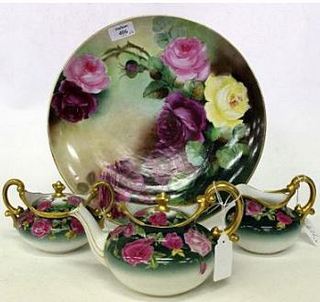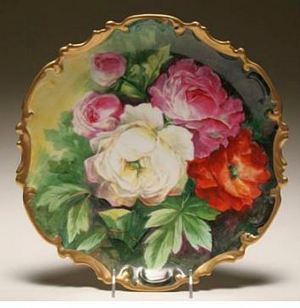LIMOGES MARKS ON PORCELAIN AND CHINAWARE:
Discover the Timeless Elegance of Limoges Porcelain

Welcome to the world of Limoges porcelain and chinaware! Limoges, a city located in west-central France, is well-known among antique and collectible enthusiasts for its exquisite porcelain and china items. These items are highly valued not only for their beauty but also for their rich history.
Although Limoges is a region rather than a specific company or studio, the term "Limoges" is most often used to refer to the fine porcelain and chinaware produced by over 300 independent producers and decorators from the region. These businesses, established by both local Limoges businessmen and foreign investors, have been flourishing since the mid-19th century up to the present day.
Despite the sheer number of producers and decorators in the region, a Limoges mark on a decorative plate or box does not necessarily correspond to any specific company or studio. Rather, it is a sign of the quality and craftsmanship that the Limoges region is famous for.
Limoges porcelain is renowned for its delicate beauty and exquisite craftsmanship. From its dainty floral motifs to its stunning Art Deco designs, Limoges porcelain has become a coveted treasure among collectors and enthusiasts. In this article, we explore the decorative styles and distinguishing marks that define authentic Limoges to tell them apart from recently imported imitations.
Identifying Authentic Limoges Marks and Backstamps
Many Limoges marks are generic, featuring a general symbol or simply the word “LIMOGES.” These marks were often made by larger factories in the area and then sold to independent decorative studios for hand-painting. Professional and occasional decorators in the surrounding region have played a significant role in making these items attractive to buyers, as their unique flair and beautiful designs add a touch of personality to each piece. These decorators usually sign their name or place their initials somewhere within the decoration or on the back, adding a personal touch to each piece.
It is important to note that there is no official registry of Limoges decorators, so many of these talented artisans remain unknown. Some of them worked directly or indirectly for larger companies, while others had their own studios, or ateliers. Despite the many unknowns surrounding Limoges marks on porcelain and chinaware, one thing is certain: these beautiful items are highly prized by collectors and enthusiasts all over the world. Whether you are a seasoned collector or a novice just starting your collection, Limoges items are sure to bring a touch of elegance and sophistication to your home.
If you've ever noticed multiple marks on Limoges items, especially stamped marks, it's likely that they were made by a certain factory and then outsourced for decoration to yet another. A third backstamp or mark may belong to a merchant company or an Exporters/Importers firm, often based in the USA.
At marks4antiques.com, our research website for antique marks and labels, we have documented and registered many of these Limoges trading logos along with a brief history or fact sheet on each company in our Ceramics section. These marks can help estimate the age of the item with a fair degree of accuracy. Vintage or antique Limoges porcelain items are more valuable than newer examples, which are sometimes made primarily for the tourist trade.
Although the quality of just about all porcelain collectibles made in Limoges is exceptionally high, regardless of the company that made or decorated them, it's essential to know the history and provenance of the item to estimate its value accurately. Furthermore, it's important to note that French Limoges is not related to items made by the American LIMOGES CHINA company and brand located in Sebring, Ohio. While the American company used the name legally as there is no restriction on using the name of places in a trademark in the US, it was intended to capitalize on the reputation of genuine French articles for marketing purposes. However, despite employing a trained master from Europe to achieve thin porcelain, the American company's efforts were disrupted by a major fire soon thereafter. Consequently, the company returned to making earthenware and semi-vitreous porcelain. While these early-to-mid-20th-century Ohio Valley products were still of high quality, they were usually slightly chunkier and less expensive to buy.
It's worth noting that many recent Limoges plates and souvenirs, such as small and cute porcelain boxes, are actually made in China or the Far East as "blank ware" (undecorated white ware) and then decorated locally in Limoges, so they can legally bear the Limoges stamp. However, the quality of these items is often not comparable to that of genuine Limoges porcelain, which has a timeless elegance that endures.
Limoges Porcelain Decorative Styles And Motifs
The most prevalent decorative style found on authentic Limoges plates, vases, and chinaware is characterized by its dainty floral motifs, simple lines, and pastel colors. Birds and other small animals are also commonly featured, while colors such as yellow, lilac, green, pink or red, and light blue dominate the color palette. Many pieces have plenty of white spaces, particularly on dinnerware, creating a refined and airy feel. Pastoral scenes or mythological classical depictions are also common, while the faces of human figures are relatively rare on Limoges items.

However, there was a notable departure from this traditional style in the early 20th century. Art Deco and Art Nouveau designs became popular during this period, and we see many examples of these styles in Limoges porcelain. Chinaware meant for use as dinnerware often features elegantly hand-painted fish or hunting scenes, as well as other food-related images like fruit, to enhance their intended use. Gilt borders or hand-applied accents in gold color add yet another fine detail to some Limoges porcelain, such as on Oyster plates. Unfortunately, gilt borders or accents often rub off or fade after a few decades, but this is a natural occurrence that can easily be retouched or restored by a professional.
Most glazes applied on Limoges porcelain are transparent and thin, yet very durable, and rarely develop signs of wear like crazing, unless used excessively or stored poorly. These exceptional features reflect the high level of craftsmanship and attention to detail characteristic of authentic Limoges porcelain.
Conclusion
The decorative styles and motifs found on authentic Limoges porcelain are both timeless and elegant, making them highly sought after by collectors and enthusiasts alike. Whether it's the delicate floral motifs, the stunning Art Deco designs, or the hand-applied accents in gold, each piece is a work of art that reflects the remarkable craftsmanship of this French region. In addition, knowing the history and provenance of your Limoges porcelain and chinaware by correctly identifying its distinguishing marks and backstamps can provide valuable insight into the age and value of your item. So, whether you're a collector or an enthusiast, delve deeper into the world of Limoges porcelain and discover the stories behind these exquisite pieces.
Unlock the true value
of your collection with our comprehensive research guides from identifying makers' marks to appraising all kinds of
antiques and collectibles.
Our up-to-date information will give you an accurate understanding of your items' worth. Don't miss out on this
valuable resource - visit our research tools today!
Search our price guide for your
own treasures





